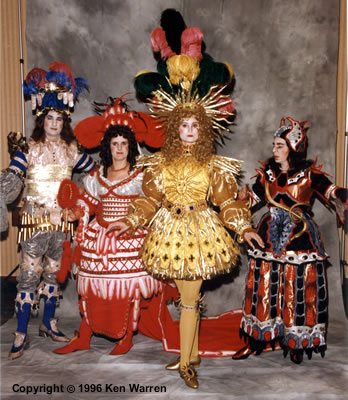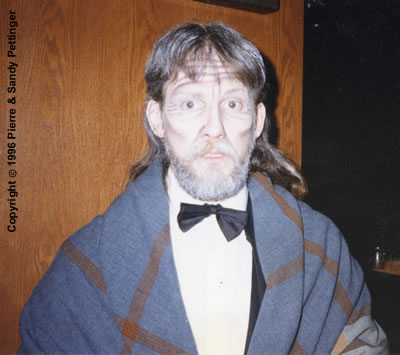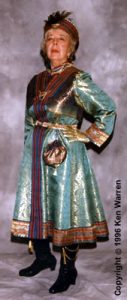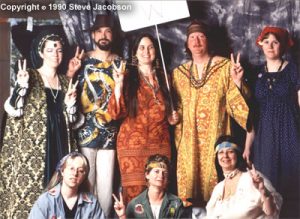CC14-H-14g: The Séance, Part 2
CC14-H-14g: The Séance, Part 2 | Division: Master | Category: Hist. Interpretation | Designer(s): Animal X | Maker(s): Animal X | Presenter(s): Randall Gross | Source: 1880-1920 | Presentation Award(s): Best in Class, Master, for Historical Interpretation (Photo ID: Pierre & Sandy Pettinger | Event Date: 1996)
Competition Staff & Rules
Staff:
- Director: Robbi Dyer
- Master of Ceremonies: Payne Fifield
- Presentation Judges: Marie Cooley, Peggy Kennedy‡, Diane Kovalcin
- Judges’ Clerk: Richard Stephens
Rules:
GENERAL MASQUERADE REGULATIONS
The following rules apply to all Costume-Con 14 stage events, including the Science Fiction/Fantasy Masquerade, the Historical Masquerade, and the Future Fashion Show.
* Purchased or rented costumes may not be shown in any competition.
* Costumes previously worn in the hallways at this convention are ineligible for stage competition.
* Each entrant may appear only once on stage per event. You may enter more than one costume, providing each appears on a different body.
* No live creatures, other than human, will be allowed backstage or on stage, with the exception of aid dogs needed by the entrant.
* Surprise the audience, not the masquerade director (or staff). If you are planning something “unique,” let us know in advance.
* No messy substances – wet, dry, or oily-no glitter, talc, snow, or other powders, foods, liquids, or any other substances that might ruin the costume of any other entrant are to be thrown and/or left on stage. If you are using stage blood or wearing body paint or make-up, be sure it won’t come off in casual contact with others. Do not leave anything on the stage that a gopher can’t pick up on a few seconds.
* No fire, flash paper, explosions, or open flame of any type – No Exceptions. Electronic flashes and/or camera flashcubes are permitted in costumes as long as you warn us first.
* Costumes must be self-contained. Connections to electrical outlets will not be available.
* There will be no live microphones on the stage for contestants. Music and/or dialogue must be recorded on audio-cassettes or as typed copy (25 words or less) for the MC to read.
* This is a PG-13 rated convention-no flagrant nudity, please.
The masquerade/fashion show director has full authority to eliminate anyone from the competition on the basis of taste, danger to the audience or contestants, violation of the above rules, or any other reason deemed sufficient.
There is, of course, no smoking at any Costume-Con 14 event.
HISTORICAL MASQUERADE
Historical Masquerade Director: Robbi Dyer
The Historical Masquerade will be held in the Washington Ballroom, starting at 7 p.m. on Sunday night. This is the competition for costumes based on or inspired by the history of human fashion to date.
To Enter:
Entry forms will be available at Registration. Complete them and return them to the “Masquerade Entry” box at Registration, by 6p.m. on Friday. Do not turn in your audio tape (if any) at this time!
Tech rehearsals will begin at 8 a.m. Saturday to 11:30 a.m., and again at 2:00 p.m. to 5:00 p.m. Saturday. A schedule of tech rehearsals and in-room judging will be available Saturday morning at Registration. Late entries will be accepted until Noon on Saturday, but cannot be guaranteed a tech rehearsal.
Rules & Regulations
DEFINING “HISTORICAL”
Any past period costume or garment is eligible for entry in this contest, with this simple limitation: If it comes from a period in which you (the costumer) wore it (or could have worn it), it’s not historical! If your costume is from a movie set in a historical period, the period that the movie represents (not the year the movie was made) will determine if your costume is eligible. For example: if you were born in 1965, a 70’s bell-bottom outfit would not be eligible; but a 1950’s sock hop outfit would be eligible; a re-creation from Saturday Night Fever or The Brady Bunch Movie would not be eligible; but a re-creation from The Great Gatsby or Mary Shelley’s “Frankenstein” would be eligible. Contact the masquerade director if you need further clarification.
SKILL DIVISIONS
The divisions for the Historical masquerade are slightly different from those used for the Science Fiction/Fantasy masquerade, but serve the same purpose, i.e., they protect the inexperienced costumer from having to compete with those more expert in this field.
Young Fan: Anyone who is less than 13 years old at the time of the convention. For awards, entries will be divided into two categories – costumes made by the young contestants, and costumes made for them by adults.
Novice: A contestant who has no previous award in any historical competition; a first entry in a historical competition with some experience in another field of costuming; a first entry in any costume competition.
Journeyman: A contestant who has won fewer than four major awards in competitions; an historical costumer with no professional experience and fewer than four major awards in any historic costume competitions; an experienced costumer who has won major awards in other fields of costuming but with little or no experience in historical costuming.
Master: A contestant who has won Best In Show in an historical masquerade at a previous CostumeCon; a contestant who has won four or more major awards in any historical costume competitions; a costuming professional who earns a significant portion of his/her income making or designing historic costumes.
Note: As in the Science Fiction/Fantasy Masquerade, any contestant may compete at a skill division higher than the one for which he or she qualifies. The division for group entries will be determined by the group’s most skilled member (who contributed significantly to the costumes). If you are uncertain of your skill level, please check with the Masquerade Director.
CATEGORIES
The Historical masquerade will feature categories for reproduction and interpretation of historical reality. Entries in both will, of course, be eligible for Best in Show, but otherwise will not be in competition with each other.
Historical Reproduction: A costume that is intended to look like it came from a particular period of history. This includes those garments and accessories which are carefully researched, documented, patterned, sewn and presented in a manner appropriate to the year they represent.
Your costume is judged on correctness of scale, line, cut, fit, fabric, detailing, and finish.
Costumes copying art will be judged on how well they re-create the appearance of the costume in the media. The exception to this would be color: clothing in black and white photos need not be done in shades of gray (unless that is the effect you’re seeking).
Historical Interpretation: A costume that intentionally departs in a visual way from the period on which it is based. This includes costumes with an obvious historical basis, but designed with heavy fantasy influence. Documentation is frequently unnecessary for this category of costume, and is not part of the scoring. Authenticity also is, obviously, not applicable. Workmanship, complexity, design excellence, creativity, and quality of finish will be the judging criteria in this category.
DOCUMENTATION:
The judges may not be familiar with the details of the garment you have created. Your documentation plays a significant part in verifying the authenticity of your entry. This is also very important to movie reproduction, or costumes copying art.
In order for the judges to have a chance to read and understand your documentation, contestants were requested send it to us prior to the convention. Late-arriving documentation may or may not be reviewed, depending on the judges’ schedules.
The body of your documentation is limited to 30 standard 8 1/2″ x 11″ pages, including text and illustrations. References or bibliographies are not included in the page count. If your entry consists of one or more costumes from the same period, same gender, being judged as a group, the 30-page limit on documentation still applies. If, however, you have two or more costumes either a) being judged as separate entries, or b) mixed men’s and women’s costumes, you may be permitted to expand your documentation accordingly if you feel it is absolutely necessary.
On Monday, at 11 a.m., we’ll have a “Meet the Judges of the Historical Masquerade” panel in the Snoqualmie Ballroom, at which time the documentation will be displayed and discussed. All entrants are strongly encouraged to participate, so that the rest of the convention members can appreciate your work.
PRE-JUDGING
In order to see your costume up close, the judges will come to your room. (If you aren’t staying at the hotel, we’ll provide a place for you to be pre-judged!)
The pre-judging will take place on Sunday prior to the masquerade. Note that if you plan to be involved with any other activities on Sunday (Fashion Show, panels, etc.) we need to know to avoid schedule conflicts.
You will be assigned a time to be judged. The judges will be on a tight schedule. We expect that judging each costume will take approximately ten minutes. You must have all parts of the costume ready for them to see. You don’t need to be wearing the costume (in fact it’s best if you are not), unless you wish to wear the appropriate underpinnings. If there’s some item you wish the judges to take special note of, make sure you are ready to point it out to them (having a checklist may help).
PRESENTATION
While the judges will evaluate your costume during the pre-judging, the time you are on the stage is an equally important part of the Historical Masquerade. This is your chance to show your costume “in action,” whether that action is simply walking around to show how your costume moves, or a presentation (serious or humorous, simple or elaborate) to set a mood, entertain, or demonstrate the manners of the age. You are welcome to do just about anything, as long as you stay within the rules outlined in the “General Masquerade Information” section, the size of the stage, and the time limits per entry.
Entries with up to four individuals will be limited to a maximum of 60 seconds on stage. Entries with five or more individuals will be allowed up to 90 seconds on stage. Any group that feels that a longer time limit is necessary for their presentation should discuss it with the director.
Miscellaneous Notes:
- Moosie Award: The Emcee (Payne Fifield)




